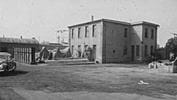Following a period as an engineer with AEG, Julius Chr. Buchholz had forged out an independent existence with the company “Julius Chr. Buchholz, Fabrik für Industrie- und Bahnbedarf” in Berlin ever since the 1920s. In 1931, he expanded his activities with the purchase of the company "Ferdinand Steinert Elektromagnetische Aufbereitungsanlagen", which had been established in Cologne in 1889.Julius Chr. Buchholz recognized the great business prospects associated with the surface treatment of aluminium, which had the potential to open up new areas of application—and markets—for the metal.
At that time, various German and foreign companies had independently succeeded in developing processes for the anodic oxidation (anodisation) of aluminium. In Germany, these techniques had become known as the “Eloxal” process in line with the German phrase for electrolytically oxidized aluminium. And now an international patent pool was looking for entrepreneurs to commercially exploit the processes.
Julius Chr. Buchholz acquired a license from this “Eloxalpool” and founded the company "Metalloxyd GmbH" in Berlin in 1932. The license granted the exclusive right to carry out contract processing in what was then the areas of northern and western Germany.
At that time, the young company used the process purely to provide corrosion protection for technical items and to introduce anodised aluminium to the architectural market. Here, the focus was on decorative applications.
However, as Julius Chr. Buchholz had been obliged to guarantee that he would provide adequate capacity for the contractually agreed areas, the need to establish additional companies became obvious.
"Metalloxyd GmbH Zweigniederlassung Köln" was entered in the commercial register in Cologne in 1936.
It was followed, in 1939, by the establishment of the legally independent company "Julius Chr. Buchholz GmbH in Hamburg". The experience was drawn from the Berlin plant, which at the time was one of the largest and most important anodising facilities in Germany. Around this time, the plants belonging to Metalloxyd Berlin were relocated several times before finally settling on a 40,000-square-metre site in Altstralau on the Rummelsberg lake.
This Berlin plant was almost completely destroyed by bombing raids during the final phase of World War II. After the end of the war, it was partially rebuilt by former employees. Initially, the production of items for other companies was also carried out, in line with the possibilities and necessities of the time. It was not until production of semi-finished aluminium components began that the company once again became active in the anodising sector.
Shortly after the currency reform of 1948, the management of the Berlin operation was subjected to compulsorily control by the Senate of East Berlin. The company was later nationalized in 1962.
The operations in Hamburg and Cologne, which had also been partially destroyed during the war, were rapidly rebuilt when peace returned. This ensured that it was possible to continue the manufacturing tradition associated with the Berlin company along the lines established by its founder.
Nonetheless, for traditional reasons, Berlin remained the headquarters of the "Metalloxyd" company for many years. The move regarding Cologne’s status took place for formal reasons in 1979.
For more than two decades the company exclusively carried out the contract anodising of aluminium components. In the mid-1950s, efforts to expand the product range in conjunction with the need to develop more rational manufacturing techniques for aluminium products led to the idea of offering the manufacturing industry aluminium strip that had already been anodised.
A strip anodising plant that made it possible to continuously anodise aluminium strips was developed and constructed in-house. At that time, the facility was the first and only one of its kind in Germany.
This development also opened up the possibility of further processing the surface-treated aluminium strip in-house.
The years 1998 to 2000 witnessed a change of strategy at the companies Metalloxyd and Steinert. As a result, the Steinert company became the strongest unit within the group—and thus also the unit with the greatest potential for development.
The Cologne anodising plant was completely destroyed by a major fire in June 2003. There was no possibility of rebuilding the facility.
At the start of 2008, the Hamburg anodising operation was taken over by the company Anoditec.







